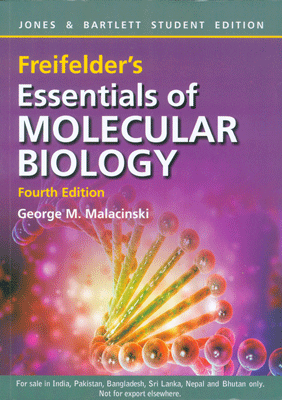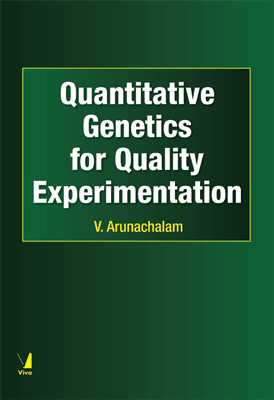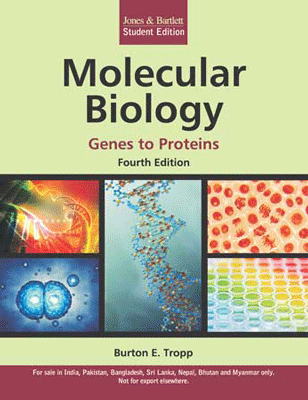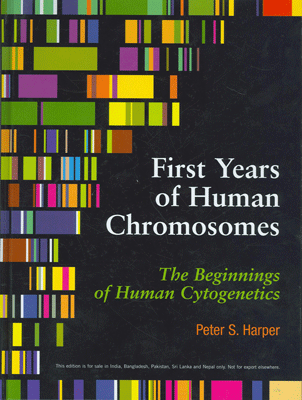Freifelder's Essentials of Molecular Biology, 4/e
Freifelder's Essentials of Molecular Biology, 4/e
₹1,075.50 ₹1,195.00 Save: ₹119.50 (10%)
Go to cartISBN: 9789384323059
Bind: Paperback
Year: 2015
Pages: 512
Size: 178 x 242 mm
Publisher: Jones & Bartlett Learning
Published in India by: Jones & Bartlett India
Exclusive Distributors: Viva Books
Sales Territory: India, Nepal, Pakistan, Bangladesh, Sri Lanka
Description:
Essentials of Molecular Biology, Fourth Edition focuses on the fundamental aspects of molecular structure and function by reviewing key features, and along the way, capsulizing them as a series of concise concepts. Thus, students are encouraged to place the essential knowledge of molecular biology into broad contexts and thereby develop both academic and personal meaning for this discipline.
Essentials of Molecular Biologyis organized into a series of modules that provides instructors with an opportunity to scale the treatment of various topics up or down, depending on the level of the students and the overall curriculum format.
Module Themes:
- The Structure of Proteins, Nucleic Acids, and Macromolecular Complexes
- Function of Macromolecules
- Coordination of Macromolecular Function in Cells
- Experimental Manipulation of Macromolecules
Features of the Fourth Edition:
A layering approach to knowledge construction is employed, developing complexity chapter-by-chapter, rather than presenting a series of detail- laden descriptions all at once.
The fourth edition of Essentials of Molecular Biology captures the essence of each major aspect of the discipline of molecular biology, from review of structure to discussion of proteomics.
Genomics, bioinformatics, and proteomics chapter - a new chapter reviews cutting-edge research.
Target Audience:
The book is designed for the students and academicians of Molecular Biology.
Contents:
About the Author • Preface • Prologue
Chapter 1: Welcome to Molecular Biology! • Goals of Molecular Biology • The Early Years • Model Biological Systems • Methodology of Molecular Biology • Rapid Progress in Molecular Biology • Putting the Details of Molecular Biology in Perspective • Concepts of Molecular Biology • Progression Diagram • Rewards from Studying Molecular Biology
Part I: The Structure of Proteins, Nucleic Acids, and Macromolecular Comlexes
Chapter 2: Macromolecules • Chemical Structures of the Major Classes of Macromolecules • Noncovalent Interactions That Determine the Three-Dimensional Structures of Proteins and Nucleic Acids • Macromolecule Isolation and Characterization
Chapter 3: Nucleic Acids • Physical and Chemical Structure of DNA • Alternate DNA Structures • Circular and Superhelical DNA • Renaturation • Hybridization • The Structure of RNA • Hydrolysis of Nucleic Acids • Sequencing Nucleic Acids • Synthesis of DNA • A Future Practical Application?
Chapter 4: The Physical Structure of Protein Molecules? Basic Features of Protein Molecules • The Folding of a Polypeptide Chain • The a Helix and ?? Secondary Structures • Protein Structure • Proteins with Subunits • Enzymes • A Future Application
Chapter 5: Macromolecular Interactions and the Structure of Complex Aggregates? A Complex DNA Structure: The E. coli Chromosome • Chromosomes and Chromatin • Interaction of DNA and Proteins That Recognize a Specific B • Sequence • Biological Membranes • Cytoskeletal Elements • A Future Practical Application?
Part II: Function of Macromolecules
Chapter 6: The Genetic Material? Early Observations on the Mechanism of Heredity • Identification of DNA As the Genetic Material • Identification of RNA As the Genetic Material of Certain Viruses • Properties of the Genetic Material • RNA As the Genetic Material
Chapter 7: DNA Replication • Semiconservative Replication of Double-Stranded DNA • Untwisting of Highly Coiled DNA Is Required for DNA Replication • Initiation of DNA Replication • Unwinding of DNA for Replication • Elongation of Newly Synthesized Strands • DNA Polymerase III Consists of Multiple Subunits • Antiparallel DNA Strands and Discontinuous Replication • The Complete DNA Replication System • Replication of Eukaryotic Chromosomes • A Future Practical Application?
Chapter 8: Transcription • Enzymatic Synthesis of RNA • Transcription Signals • Classes of RNA Molecules • Transcription in Eukaryotes • Means of Studying Intracellular RNA • A Future Practical Application?
Chapter 9: Translation • Outline of Translation • The Genetic Code • The Wobble Phenomenon • Polycistronic mRNA • Overlapping Genes • Polypeptide Synthesis • Stages of Polypeptide Synthesis in Prokaryotes • Complex Translation Units • Antibiotics • A Future Practical Application?
Chapter 10: Mutations, Mutagenesis, and DNA Repair? Types of Mutations • Biochemical Basis of Mutants • Mutagenesis • Induced Mutations • Reversion • Reversion As a Means of Detecting Mutagens and Carcinogens • DNA Repair Mechanisms • Spontaneous Mutations and Their Repair • Repair by Direct Reversal • Excision Repair • Recombinational Repair • The SOS Response • Future Practical Applications?
Part III: Coordination of Macromolecular Function in Cells
Chapter 11: Regulation of Gene Activity in Prokaryotes? Principles of Regulation • Transcriptional Regulation • Posttranscriptional Control • Feedback Inhibition and Allosteric Control • A Future Practical Application?
Chapter 12: Regulation of Gene Activity in Eukaryotes? Important Differences in the Genetic Organization of Prokaryotes and Eukaryotes • The Regulation of Transcription Initiation • The Regulation of RNA Processing • Regulation of Nucleocytoplasmic mRNA Transport • Regulation of mRNA Stability • Regulation of Translation • Regulation of Protein Activity • Gene Rearrangement: Joining of Coding Sequences in the Immune System • A Future Practical Application?
Chapter 13: Genomics and Proteomics Drive Information-Age Biology? Genomics- The Use of DNA As a Starting Point for Discovery • Bioinformatics-Using DNA Sequence Information to Build Knowledge • Proteomics Focuses on the Totality of Proteins: Their Numbers, Structures, Interactions, Locations, and Functions • The Emergence of a New ?Logic of Molecular Biology?? • A Future Practical Application?
Part IV: Experimental Manipulation of Macromolecules
Chapter 14: Transposons, Plasmids, and Bacteriophage? Transposable Elements-Their Discovery Surprised Molecular Biologists • Transposable Elements in Eukaryotes • Plasmids • Plasmid-Borne Genes • Plasmid Transfer • Plasmid DNA Replication • Bacteriophage • Stages in the Lytic Life Cycle of a Typical Phage • Specific Phage • Transducing Phage • Transposons, Plasmids, and Bacteriophage in Genetic Engineering • A Future Practical Application?
Chapter 15: Recombinant DNA and Genetic Engineering: Molecular Tailoring of Genes? Plasmids Act As Nature's Interlopers • Restriction Enzymes Function As Nature's Pinking Shears • Genetic Interlopers: Vectors Function As Vehicles for Transferring Genes • Detection of Recombinant DNA Molecules • Site-Specific Mutagenesis Using Bacteriophage M- 13 Vector • Applications of Genetic Engineering
Chapter 16: Molecular Biology Is Expanding Its Reach? Uses of Recombinant DNA Technology in Research • Uses of Recombinant DNA Technology in Medicine • Uses of Recombinant DNA Technology in Agriculture • Other Commercial and Industrial Applications • Molecular Biology: On the Front Line of the Battle Against AIDS • Social and Ethical Issues
POSTSCRIPT: Postscript to Your Review of Molecular Biology? Molecular Biology Is Enjoying a Golden Era! • Speculation-Let's Anticipate a Few Discoveries in Molecular Biology! • Enhance Your Ability to Learn Molecular Biology! • Consider Becoming a Molecular Biologist!
APPENDIX: Chemical Principles Important for Understanding Molecular Biology • Structure of the Atom • Chemical Bonds • The Ionization of Water-The pH Scale • Organic Chemistry • Concluding Note
List of Essential Concepts
Glossary
Answers to Questions and Problems
Index
About the Author:
George M. Malacinski, Professor of Biology, Indiana University
As an undergraduate Prof. Malacinski studied biology and chemistry at Boston University. He did undergraduate research on the bacteriophage life cycle and became interested in the value of prokaryotic organisms for understanding fundamental life processes. As a graduate student at Indiana University he researched phosphorus metabolism in bacteria. For postdoctoral research (at the University of Washington-Seattle) he broadened his training by studying the developmental genetics of the mammalian pancreas. Returning to Indiana University as a faculty member he established a research program in the molecular genetics of early amphibian embryogenesis. His research interests most recently have included the analysis of molecular regulatory mechanisms of early muscle cell differentiation. He has taught Molecular Biology to undergraduates for the past 10 years.






